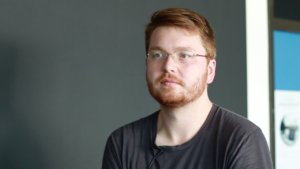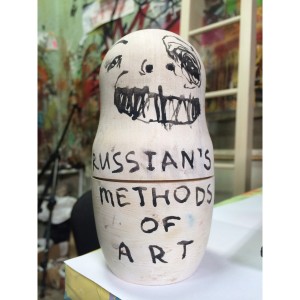PRESENTATION
Well, I think we – I mean we [vary] between different kinds of languages like in a way. We have kind of like different characters, that people bring into the platform DIS.art, to communicate in a variety of ways, I guess. I mean, I think I – we definitely – we don’t have like a standard oppositional critique, you know. Like, we’ve developed over time, you know, there is like – we don’t do like news paper, you know. We don’t like – we don’t fall into a certain kind of like aesthetic of critique which I think is like been popularized in contemporary art, particularly in contemporary art that wants to be taken really seriously and be really political and dadada. And for us, we are political, we are serious, we are all these things, but we don’t have to – we don’t have to, you know, like put on this pretense and like use those like kind of like aesthetic traps in order to be those things, you know. So, that just I think, like kind of a continuous aesthetic language that we’ve developed. Like, a way of talking about things, that I think, are pretty like serious and important urgent, critical and all these things, but not doing it in the usual standard mode, that we’re kind of like really, you know, bored by, I guess.
I don’t think people from the outside understand how much budget effects like what you can produce or do. Because we work in video, because we prioritize making and generating new productions and new videos and new commissions. The installations kind of don’t take like – the installations become a problem you have to solve, you know. More than a statement you’re trying to make. Like it’s a little bit of both, but you’re working with like certain limitations and you have to kind of like do your best to – I don’t know, like make it as communicative as possible, as immersive as possible, as fierce as possible. But in the end, you know, like it really depends a lot – what you can do. You know, for instance like I mean, I could go to exhibitions like the De Young, with our first show for DIS.art and we were given the lobby, you know, to do something. Which we love lobby art, this is like, this is great. You know, it’s a free space, anyone can walk in anytime. You don’t have to have a ticket, you can sit down, whatever. You know, we had, you know, endless ideas for things, that we could do in there. But in the end, you know, what is possible? We had – we happened – they happened to have all these screens. So, we were like: “ We’re using your screens.“ That’s it. And I think, what was really cool, that the artist let us put all of their works on the same screen and have it run almost like a single program. Like a variety show. So, that was really the statement – that we create a variety show. And it was one screen that we all shared, and it was like an hour program. And that sort of was – that was it, really simple. For Casa Encendida, which was like the next show after the De Young, I think we did, we had three rooms, projectors, different kinds of seats in each room. One was with a couch made out of hay, one was, you know, like some pipes, that would normally be underground, kind of like representing infrastructure something like this. And then we had a kind of like exploded, expanded PDF that we turned into lightboxes, so we darkened – like all the rooms were dark, but then you could kind of like, as if it was like the, you know, the stations of the cross or something at church, where you could walk through and see like our thinking, you know. Behind, what was playing on the screen. You got like a little bit more of a backstory in our, like in the topics that were coming up in all of the videos. So, that were like site-specific teach room and whatever it was playing on the projector. Whatever, like that. So, you know, it’s like a problem solving, basically.

















